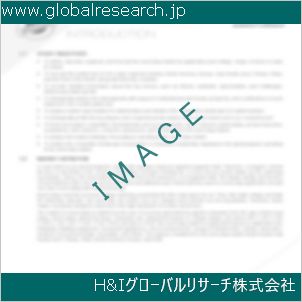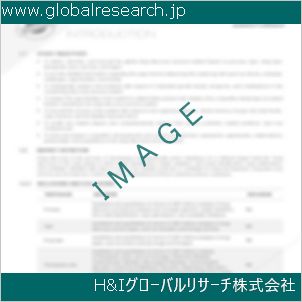Table of Contents
1 Industry Overview of Copper(I)Oxide
1.1 Definition and Specifications of Copper(I)Oxide
1.1.1 Definition of Copper(I)Oxide
1.1.2 Specifications of Copper(I)Oxide
1.2 Classification of Copper(I)Oxide
1.3 Applications of Copper(I)Oxide
1.3.1 Nuclear Application
1.3.2 Non-Nuclear Application
1.4 Industry Chain Structure of Copper(I)Oxide
1.5 Industry Overview and Major Regions Status of Copper(I)Oxide
1.5.1 Industry Overview of Copper(I)Oxide
1.5.2 Global Major Regions Status of Copper(I)Oxide
1.6 Industry Policy Analysis of Copper(I)Oxide
1.7 Industry News Analysis of Copper(I)Oxide
2 Manufacturing Cost Structure Analysis of Copper(I)Oxide
2.1 Raw Material Suppliers and Price Analysis of Copper(I)Oxide
2.2 Equipment Suppliers and Price Analysis of Copper(I)Oxide
2.3 Labor Cost Analysis of Copper(I)Oxide
2.4 Other Costs Analysis of Copper(I)Oxide
2.5 Manufacturing Cost Structure Analysis of Copper(I)Oxide
2.6 Manufacturing Process Analysis of Copper(I)Oxide
3 Technical Data and Manufacturing Plants Analysis of Copper(I)Oxide
3.1 Capacity and Commercial Production Date of Global Copper(I)Oxide Major Manufacturers in 2023
3.2 Manufacturing Plants Distribution of Global Copper(I)Oxide Major Manufacturers in 2023
3.3 R&D Status and Technology Source of Global Copper(I)Oxide Major Manufacturers in 2023
3.4 Raw Materials Sources Analysis of Global Copper(I)Oxide Major Manufacturers in 2023
4 Capacity, Production and Revenue Analysis of Copper(I)Oxide by Regions, Types and Manufacturers
4.1 Global Capacity, Production and Revenue of Copper(I)Oxide by Regions 2019-2024
4.2 Global and Major Regions Capacity, Production, Revenue and Growth Rate of Copper(I)Oxide 2019-2024
4.3 Global Capacity, Production and Revenue of Copper(I)Oxide by Types 2019-2024
4.4 Global Capacity, Production and Revenue of Copper(I)Oxide by Manufacturers 2019-2024
5 Price, Cost, Gross and Gross Margin Analysis of Copper(I)Oxide by Regions, Types and Manufacturers
5.1 Price, Cost, Gross and Gross Margin Analysis of Copper(I)Oxide by Regions 2019-2024
5.2 Price, Cost, Gross and Gross Margin Analysis of Copper(I)Oxide by Types 2019-2024
5.3 Price, Cost, Gross and Gross Margin Analysis of Copper(I)Oxide by Manufacturers 2019-2024
6 Consumption Volume, Consumption Value and Sale Price Analysis of Copper(I)Oxide by Regions, Types and Applications
6.1 Global Consumption Volume and Consumption Value of Copper(I)Oxide by Regions 2019-2024
6.2 Global and Major Regions Consumption Volume, Consumption Value and Growth Rate of Copper(I)Oxide 2019-2024
6.3 Global Consumption Volume and Consumption Value of Copper(I)Oxide by Types 2019-2024
6.4 Global Consumption Volume and Consumption Value of Copper(I)Oxide by Applications 2019-2024
6.5 Sale Price of Copper(I)Oxide by Regions 2019-2024
6.6 Sale Price of Copper(I)Oxide by Types 2019-2024
6.7 Sale Price of Copper(I)Oxide by Applications 2019-2024
6.8 Market Share Analysis of Copper(I)Oxide by Different Sale Price Levels
7 Supply, Import, Export and Consumption Analysis of Copper(I)Oxide
7.1 Supply, Consumption and Gap of Copper(I)Oxide 2019-2024
7.2 Global Capacity, Production, Price, Cost, Revenue, Supply, Import, Export and Consumption of Copper(I)Oxide 2019-2024
7.3 USA Capacity, Production, Price, Cost, Revenue, Supply, Import, Export and Consumption of Copper(I)Oxide 2019-2024
7.4 EU Capacity, Production, Price, Cost, Revenue, Supply, Import, Export and Consumption of Copper(I)Oxide 2019-2024
7.5 China Capacity, Production, Price, Cost, Revenue, Supply, Import, Export and Consumption of Copper(I)Oxide 2019-2024
7.6 Japan Capacity, Production, Price, Cost, Revenue, Supply, Import, Export and Consumption of Copper(I)Oxide 2019-2024
8 Major Manufacturers Analysis of Copper(I)Oxide
8.1 Manufacturer One
8.1.1 Company Profile
8.1.2 Product Picture and Specifications
8.1.2.1 Type I
8.1.2.2 Type II
8.1.2.3 Type III
8.1.3 Capacity, Production, Price, Cost, Gross and Revenue
8.1.4 Contact Information
8.2 Manufacturer Two
8.2.1 Company Profile
8.2.2 Product Picture and Specifications
8.2.2.1 Type I
8.2.2.2 Type II
8.2.2.3 Type III
8.2.3 Capacity, Production, Price, Cost, Gross and Revenue
8.2.4 Contact Information
8.3 Manufacturer Three
8.3.1 Company Profile
8.3.2 Product Picture and Specifications
8.3.2.1 Type I
8.3.2.2 Type II
8.3.2.3 Type III
8.3.3 Capacity, Production, Price, Cost, Gross and Revenue
8.3.4 Contact Information
8.4 Manufacturer Four
8.4.1 Company Profile
8.4.2 Product Picture and Specifications
8.4.2.1 Type I
8.4.2.2 Type II
8.4.2.3 Type III
8.4.3 Capacity, Production, Price, Cost, Gross and Revenue
8.4.4 Contact Information
8.5 Manufacturer Five
8.5.1 Company Profile
8.5.2 Product Picture and Specifications
8.5.2.1 Type I
8.5.2.2 Type II
8.5.2.3 Type III
8.5.3 Capacity, Production, Price, Cost, Gross and Revenue
8.5.4 Contact Information
…
9 Marketing Trader or Distributor Analysis of Copper(I)Oxide
9.1 Marketing Channels Status of Copper(I)Oxide
9.2 Traders or Distributors with Contact Information of Copper(I)Oxide by Regions
9.3 Ex-work Price, Channel Price and End Buyer Price Analysis of Copper(I)Oxide
9.4 Regional Import, Export and Trade Analysis of Copper(I)Oxide
10 Industry Chain Analysis of Copper(I)Oxide
10.1 Upstream Major Raw Materials Suppliers Analysis of Copper(I)Oxide
10.1.1 Major Raw Materials Suppliers with Contact Information Analysis of Copper(I)Oxide
10.1.2 Major Raw Materials Suppliers with Supply Volume Analysis of Copper(I)Oxide by Regions
10.2 Upstream Major Equipment Suppliers Analysis of Copper(I)Oxide
10.2.1 Major Equipment Suppliers with Contact Information Analysis of Copper(I)Oxide
10.2.2 Major Equipment Suppliers with Product Pictures Analysis of Copper(I)Oxide by Regions
10.3 Downstream Major Consumers Analysis of Copper(I)Oxide
10.3.1 Major Consumers with Contact Information Analysis of Copper(I)Oxide
10.3.2 Major Consumers with Consumption Volume Analysis of Copper(I)Oxide by Regions
10.4 Supply Chain Relationship Analysis of Copper(I)Oxide
11 Development Trend of Analysis of Copper(I)Oxide
11.1 Capacity, Production and Revenue Forecast of Copper(I)Oxide by Regions and Types
11.1.1 Global Capacity, Production and Revenue of Copper(I)Oxide by Regions 2024-2029
11.1.2 Global and Major Regions Capacity, Production, Revenue and Growth Rate of Copper(I)Oxide 2024-2029
11.1.3 Global Capacity, Production and Revenue of Copper(I)Oxide by Types 2024-2029
11.2 Consumption Volume and Consumption Value Forecast of Copper(I)Oxide by Regions, Types and Applications
11.2.1 Global Consumption Volume and Consumption Value of Copper(I)Oxide by Regions 2024-2029
11.2.2 Global and Major Regions Consumption Volume, Consumption Value and Growth Rate of Copper(I)Oxide 2024-2029
11.2.3 Global Consumption Volume and Consumption Value of Copper(I)Oxide by Types 2024-2029
11.2.4 Global Consumption Volume and Consumption Value of Copper(I)Oxide by Applications 2024-2029
11.3 Supply, Import, Export and Consumption Forecast of Copper(I)Oxide
11.3.1 Supply, Consumption and Gap of Copper(I)Oxide 2024-2029
11.3.2 Global Capacity, Production, Price, Cost, Revenue, Supply, Import, Export and Consumption of Copper(I)Oxide 2024-2029
11.3.3 USA Capacity, Production, Price, Cost, Revenue, Supply, Import, Export and Consumption of Copper(I)Oxide 2024-2029
11.3.4 EU Capacity, Production, Price, Cost, Revenue, Supply, Import, Export and Consumption of Copper(I)Oxide 2024-2029
11.3.5 China Capacity, Production, Price, Cost, Revenue, Supply, Import, Export and Consumption of Copper(I)Oxide 2024-2029
11.3.6 Japan Capacity, Production, Price, Cost, Revenue, Supply, Import, Export and Consumption of Copper(I)Oxide 2024-2029
12 New Project Investment Feasibility Analysis of Copper(I)Oxide
12.1 New Project SWOT Analysis of Copper(I)Oxide
12.2 New Project Investment Feasibility Analysis of Copper(I)Oxide
13 Conclusion of the Global Copper(I)Oxide (CAS 1317-39-1) Industry 2024 Market Research Report
| ※参考情報 酸化銅(I)、一般的に銅(I)酸化物として知られる化合物は、化学式Cu₂Oで表され、銅の非安定な酸化状態である銅(I)の酸化物です。CAS番号は1317-39-1です。この物質は、自然界では非常に古くから知られ、銅鉱石の一部としても存在しています。銅(I)酸化物は金属架橋性の構造を持ち、赤色の固体として見られることが多いです。 酸化銅(I)は、一般的に様々な物理的および化学的特性を持っています。例えば、高い導電性や耐酸性、または高い温度での安定性などが挙げられます。これらの特性により、酸化銅(I)は多様な用途に利用されています。また、銅(I)酸化物は、例えば、粒径や結晶構造の違いによってその特性が変わるため、異なるタイプの酸化銅(I)が生成されることもあります。 酸化銅(I)は主に以下のような用途で知られています。最も顕著な用途の一つは半導体材料です。銅(I)酸化物は、特に薄膜トランジスタや光電気化学セルなどの電子デバイスの製造に適しています。さらには、触媒としての利用もあります。例えば、酸化銅(I)は化学反応を促進する触媒として使用されることがあり、特に特定の有機化合物の合成において効果的です。 さらに、銅(I)酸化物は、その抗菌特性から医療分野でも注目されています。銅は本来抗菌特性を持つ金属ですが、酸化銅(I)にすることでその特性がさらに強化され、表面に存在する細菌やウイルスを減少させる効果があります。このため、酸化銅(I)は創傷治療や医療機器の表面コーティングなどに使われることがあります。 また、銅(I)酸化物は色素や顔料としても使用されることがあります。特に赤色の顔料として、建材やプラスチック、塗料などに添加されることが多く、これによって製品に美しい赤色を与えることができます。 酸化銅(I)を利用した関連技術では、太陽光発電技術が挙げられます。最近の研究では、酸化銅(I)を用いた新しいタイプの太陽電池が開発されています。この電池は、酸化銅(I)の光電効果を利用して太陽光を効率的に電力に変換することが可能です。このような技術は、再生可能エネルギーの推進に寄与するものであり、持続可能なエネルギーの未来を見据えた重要な領域です。 酸化銅(I)の製造方法も多岐にわたります。一般的には、銅の酸化反応によって生成されます。このプロセスは、銅を高温で酸化することによって行われることが多く、反応条件によって粒子的な大きさや結晶構造を調整することができます。また、燃焼法や化学蒸着法など、さまざまな技術が利用され、それぞれが異なる特性を持った酸化銅(I)を生成します。 一方で、酸化銅(I)には注意点もあります。特に、その酸化還元特性によって、周囲の環境と反応する可能性があるため、取り扱いには注意が必要です。また、酸化銅(I)は安定性が低いため、酸化銅(II)に変化することがあります。この変化は、使用条件や保存環境によって影響を受けるため、適切な管理が要求されます。 さらに、酸化銅(I)の研究は、さまざまな新たな応用の可能性を拓くものです。例えば、ナノテクノロジーの分野では、ナノサイズの酸化銅(I)が新しい機能性材料として注目されています。これにより、より高い性能を持った電子デバイスや新しい医療技術の開発が進められています。 総じて、酸化銅(I)はそのユニークな物理的および化学的特性から、多岐にわたる用途を持つ有望な材料です。今後の研究や技術開発において、この化合物がどのように活用されていくのかは注目に値する分野であり、持続可能な社会の実現に向けた重要な役割を果たすことが期待されています。 |
❖ 免責事項 ❖
http://www.globalresearch.jp/disclaimer












